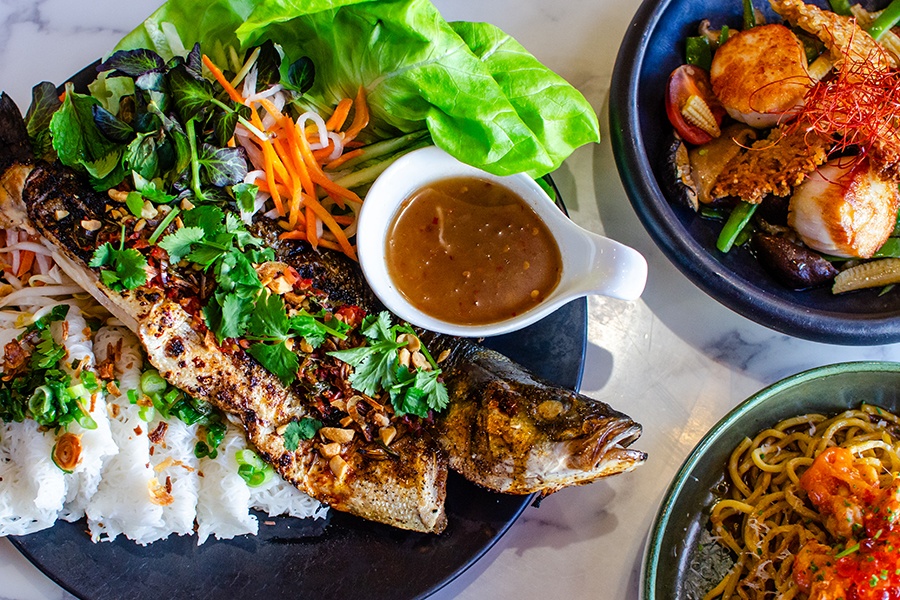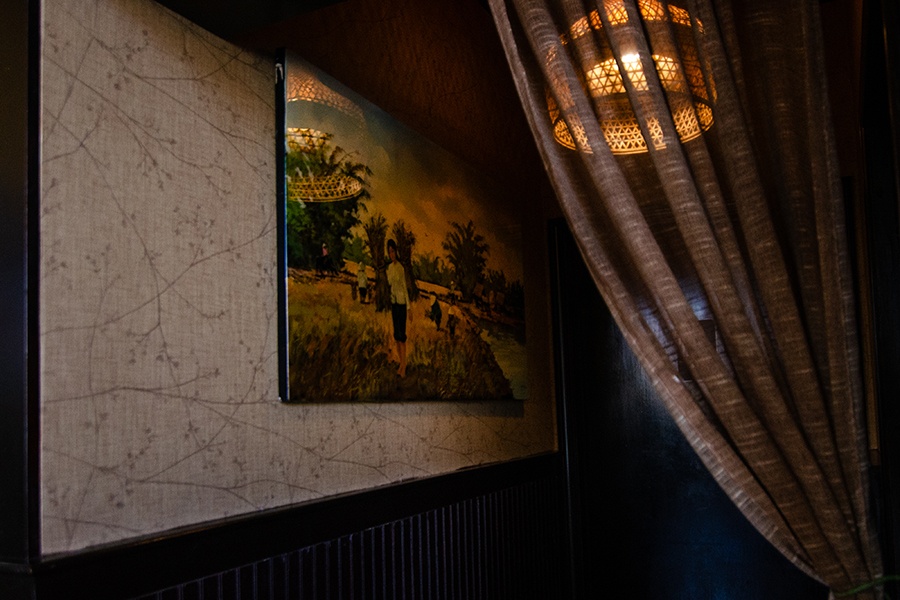In Quincy, Lê Madeline Serves Destination-Worthy Modern Vietnamese
The revamp of 10-year-old Pho Linh showcases Vietnamese cuisine and cocktails with a twist.
From a fried lobster roll with tart tamarind sauce to a tangle of garlic noodles topped with basil-buttered crawfish, a reinvented Quincy restaurant aims to bring a new vision of Vietnamese dining to Greater Boston. After a decade in business, noodle shop Pho Linh has recently become Lê Madeline, paying homage to tradition while putting a modern spin on Vietnamese cuisine, drawing inspiration from the second-generation Vietnamese American upbringings of restaurateur Tam Le and executive chef Peter Nguyen. The result? A destination-worthy restaurant that’s sure to draw crowds from Boston and beyond for family-style feasts of herby whole roasted branzino or lemongrass-marinated pork chop, not to mention intriguing cocktails showcasing Vietnamese flavors.

Lê Madeline features a koi and water lily mural by Dallas, Texas-based artist Phung Banh. / Photo by Rachel Leah Blumenthal
“Prior to COVID, I was already feeling like Pho Linh needed some sort of refresh,” says Le. He’d bought the restaurant from his parents back in 2013; at the time, it was a second location of the family’s Dorchester staple Pho Hoa. He rebranded the Quincy restaurant as Pho Linh the following year, positioning it as a traditional Vietnamese noodle shop. Then, the pandemic hit, and Pho Linh’s next act became clearer as Le really started thinking about what dining would look like after COVID. “What value do restaurants bring to people?” he recalls wondering. “How can we make the overall dining experience more memorable?”
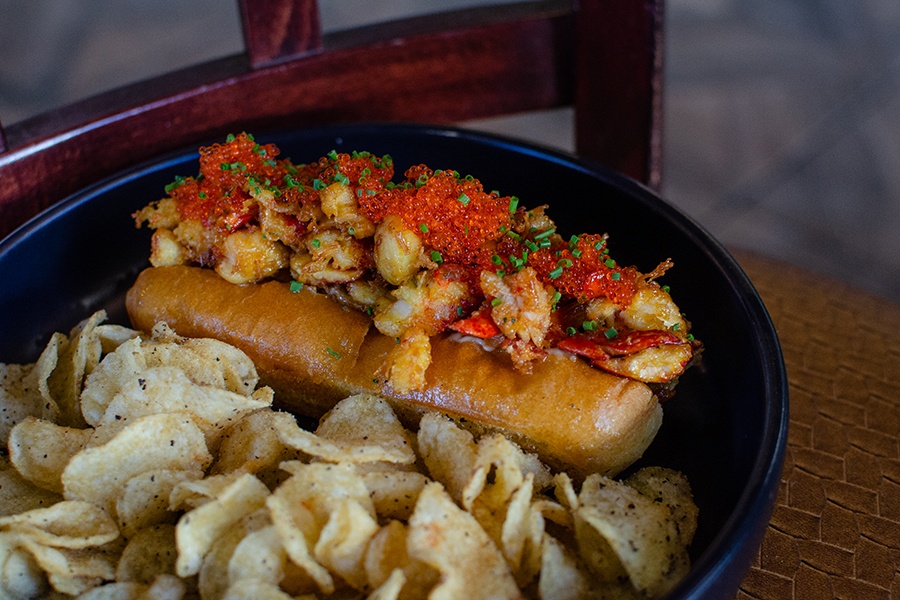
Lê Madeline’s tôm hùm rang me: fried lobster roll on warm buttered brioche with tamarind, tobiko, and potato chips. / Photo by Rachel Leah Blumenthal
That was the birth of the idea of Lê Madeline, he says—a more modern Vietnamese concept—but Le isn’t a chef and knew he had to find the right person to execute the idea. Thanks to a mutual friend, he connected with Peter Nguyen, a Little Donkey alum and Dorchester native (he grew up right down the street from Pho Hoa, coincidentally) who most recently was making waves down in Houston at a restaurant called Riel. The duo—plus industry vet Allan Yee, getting creative on the beverage side of the equation—introduced Lê Madeline as a pop-up at Pho Linh late last year, and as of early February, the transition is complete.
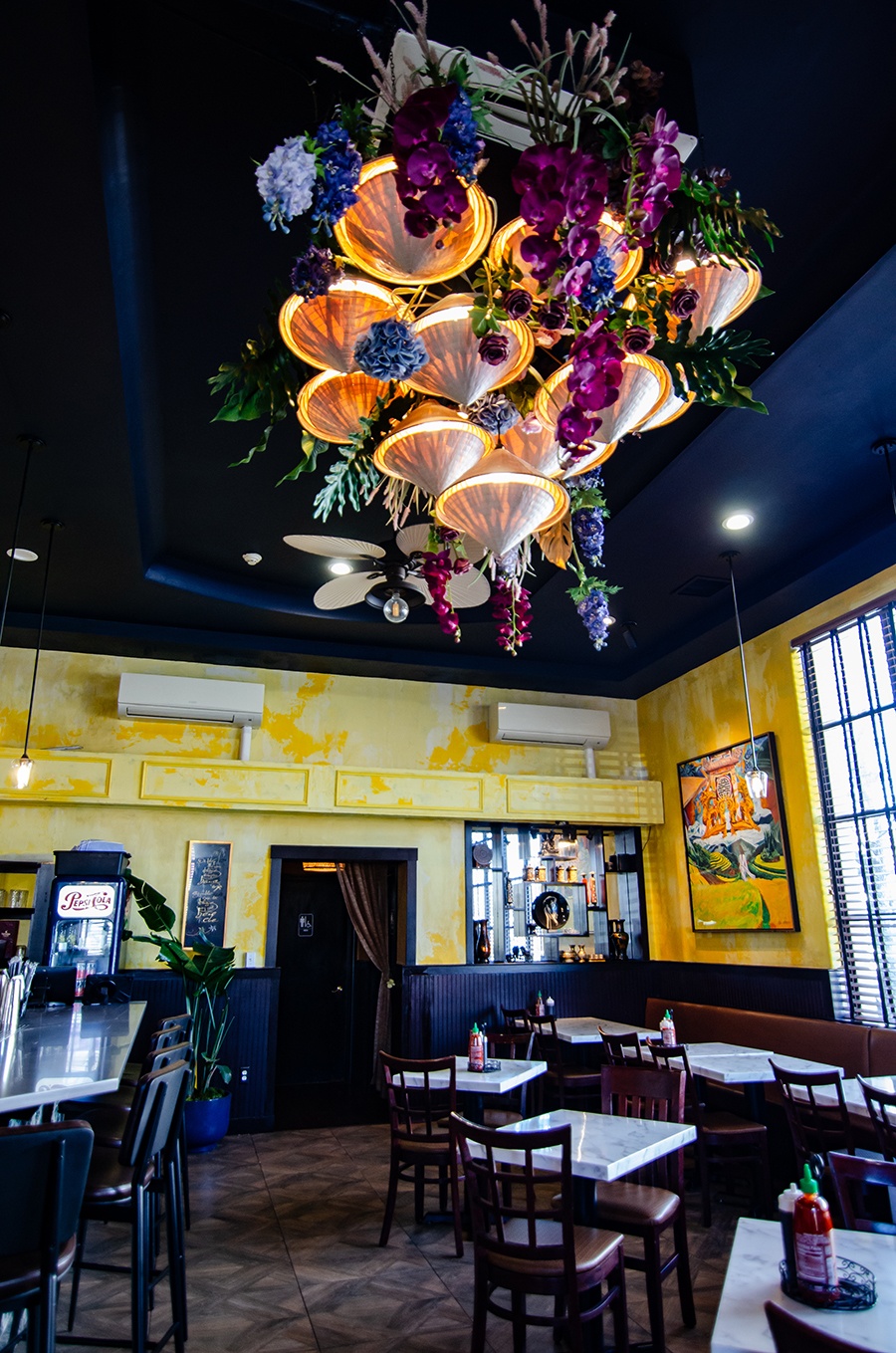
Lê Madeline. The large painting in the back corner is a commissioned work by New York-based artist Ari Lankin and depicts Tam Le’s parents. Le and Lankin painted together at Brandeis and have been friends for years. / Photo by Rachel Leah Blumenthal
It’s not entirely goodbye to Pho Linh, as lunch service remains a tribute to the old restaurant, featuring a lengthy selection of phở (noodle soups), com dia (rice plates), bún (vermicelli bowls), and more. A few Pho Linh favorites even make it onto the dinner menu, including bún bò Huế, a famous noodle soup from Le’s parents’ home city of Huế in central Vietnam. But otherwise, dinner is “where all the magic happens,” says Le, with the menu telling the stories of Le and Nguyen’s upbringing and restaurant experience.
“We’re trying to do something that our family and ancestors would be proud of,” says Nguyen, “keeping the core there with our own twist.” That means influences from Nguyen’s time down South, nods to New England cuisine, and inspiration from beyond. “It doesn’t even have to be specifically Vietnamese,” says Nguyen. “It has a lot to do with my family and how we eat at home. We’re just trying to tell a story of who we are, but deep down we’re still Vietnamese to this day. This is what we love, and this is what we care for.”

Lê Madeline’s gỏi vịt: pan-seared duck breast salad with banana blossoms, cabbage, herbs, crisps, and mắm gừng Dijonnaise. / Photo by Rachel Leah Blumenthal
So diners will find, for example, crispy fried chicken wings, a nod to one of Nguyen’s favorite things to eat growing up. Here, they’re jazzed up with garlicky nước chấm, the ubiquitous fish-sauce-based Vietnamese dipping sauce, plus pickled Fresnos. And then there are the Việt Cajun crawfish noodles, an ode to Nguyen’s time in Texas, especially the crawfish boils at his fiancée Theresa’s family gatherings. It’s a bit of a reflection, too, of Nguyen’s extensive Italian restaurant experience. “He came up doing a lot of pasta,” says Le.
And this is New England, so there’s a lobster roll—and not just any lobster roll, but a frontrunner for a new favorite in the region. The flavors deviate from New England tradition a bit: Served on buttery brioche, fried lobster is dressed with a tamarind sauce and tobiko. There’s also bò lúc lắc, a well-known Vietnamese dish of marinated cubes of steak that just so happens to be reminiscent of New England steak tips, says Le. “We’ve found ways to take things that might be familiar and put a Vietnamese spin on them and also take classic Vietnamese dishes and put a modern spin on them,” he says.
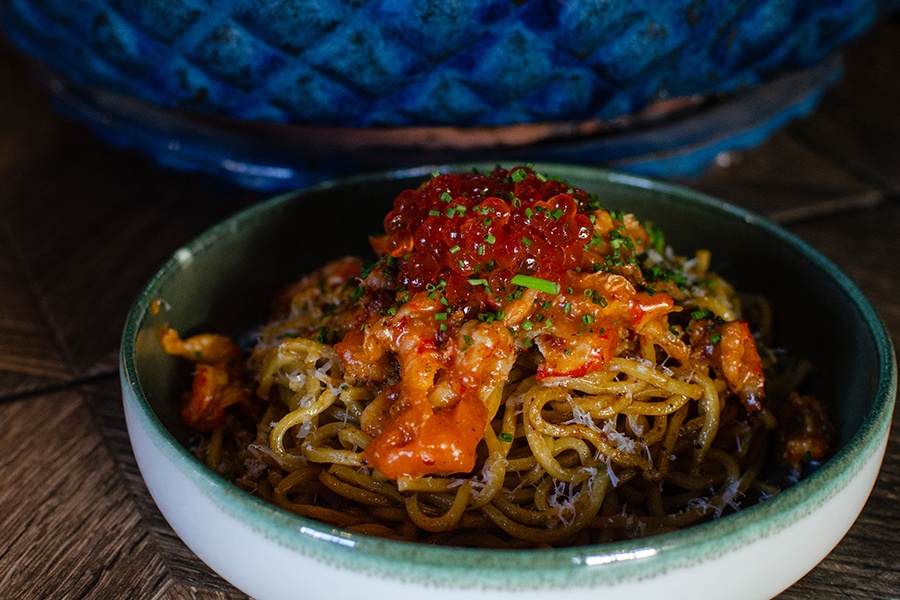
Lê Madeline’s Việt Cajun crawfish noodles: garlic noodles, basil-buttered crawfish, parmesan, salmon roe. / Photo by Rachel Leah Blumenthal
While the whole menu is tailored toward sharing everything family-style, a couple of large-format dishes really drive home the idea. Cá nướng, Vietnamese roasted fish, is prepared here with a whole roasted branzino, for example, butterflied and served with a green onion chimichurri (“I worked with a lot of steak and chimichurri back in the day,” says Nguyen), steamed vermicelli, lots of fresh herbs, and pineapple anchovy sauce. Pick some of the smaller dishes, too, and you can easily feed two or three.
Whatever the dish, there are layers of flavor—maybe a spicy kick, maybe savory, maybe sweet. “I’m a big umami guy,” says Nguyen. “I like to punch your mouth in the face, blow you away, keep you going for seconds.”

Lê Madeline has a full liquor license and a creative cocktail list. / Photo by Rachel Leah Blumenthal
On the cocktail side, Yee—an alum of Oishii in Boston, Hotel Marlowe in Cambridge, and lots of other places over a 30-year career—has created a list of Vietnamese-influenced drinks with ingredients like pandan leaves and Vietnamese coffee. It’s been a long time since there’s been a true Vietnamese concept drink list in Greater Boston, says Yee, thinking back to Pho Republique in Boston’s South End, which closed in 2009. He’s particularly excited about his espresso martini-like Second Wind, mixing Vietnamese coffee with Galliano, fig, vodka, and banana. The mezcal-based Bonfire is also “an interesting drink,” he says, with lime juice, pear liqueur, bitters, and buzz buttons—little flowers that numb your mouth similarly to a Sichuan peppercorn, causing the flavor of the drink to change as you sip it.
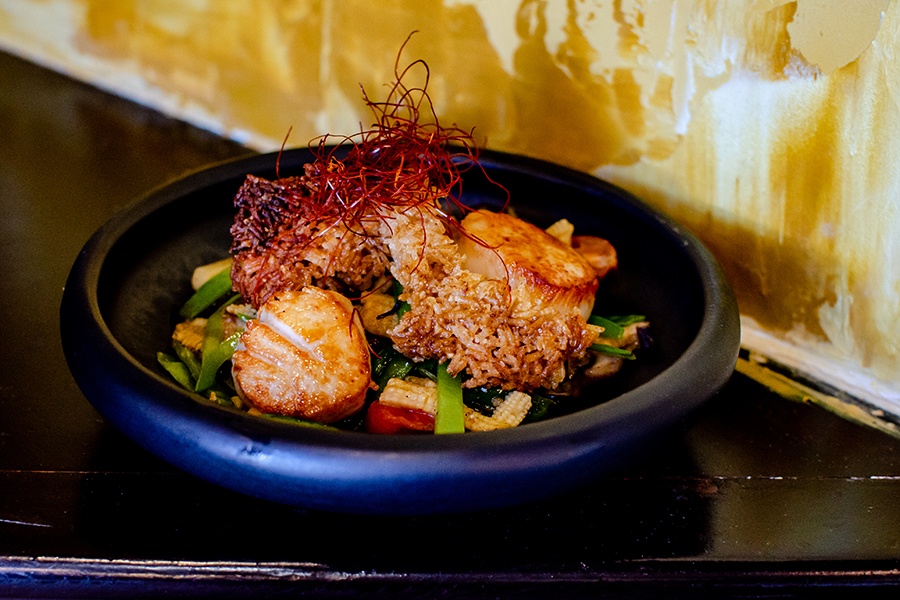
Lê Madeline’s cơm cháy sò điệp nướng: crispy caramelized rice, pan-seared scallops, baby corn, pickled shiitakes, snow peas, and sweet soy. / Photo by Rachel Leah Blumenthal
Renovations to the restaurant that Le began during the pandemic have resulted in an inviting space that feels casual and sunny by day, but a little swankier when night falls. An eye-catching light fixture in the main dining room and intricate blue tiling around the bar area help liven up the space, along with some gorgeous art, including a large mural of koi and water lilies by Dallas, Texas-based artist Phung Banh.
Following a couple months of the initial Lê Madeline pop-up, and now a little over a week of regular service, the team is optimistic. “I think we’ve tried to hug this fine line of keeping tradition, but bringing our modern generation into it,” says Le. “It’s very important to us to remember how we grew up and also make sure we’re bringing everything we’ve learned to the table.”
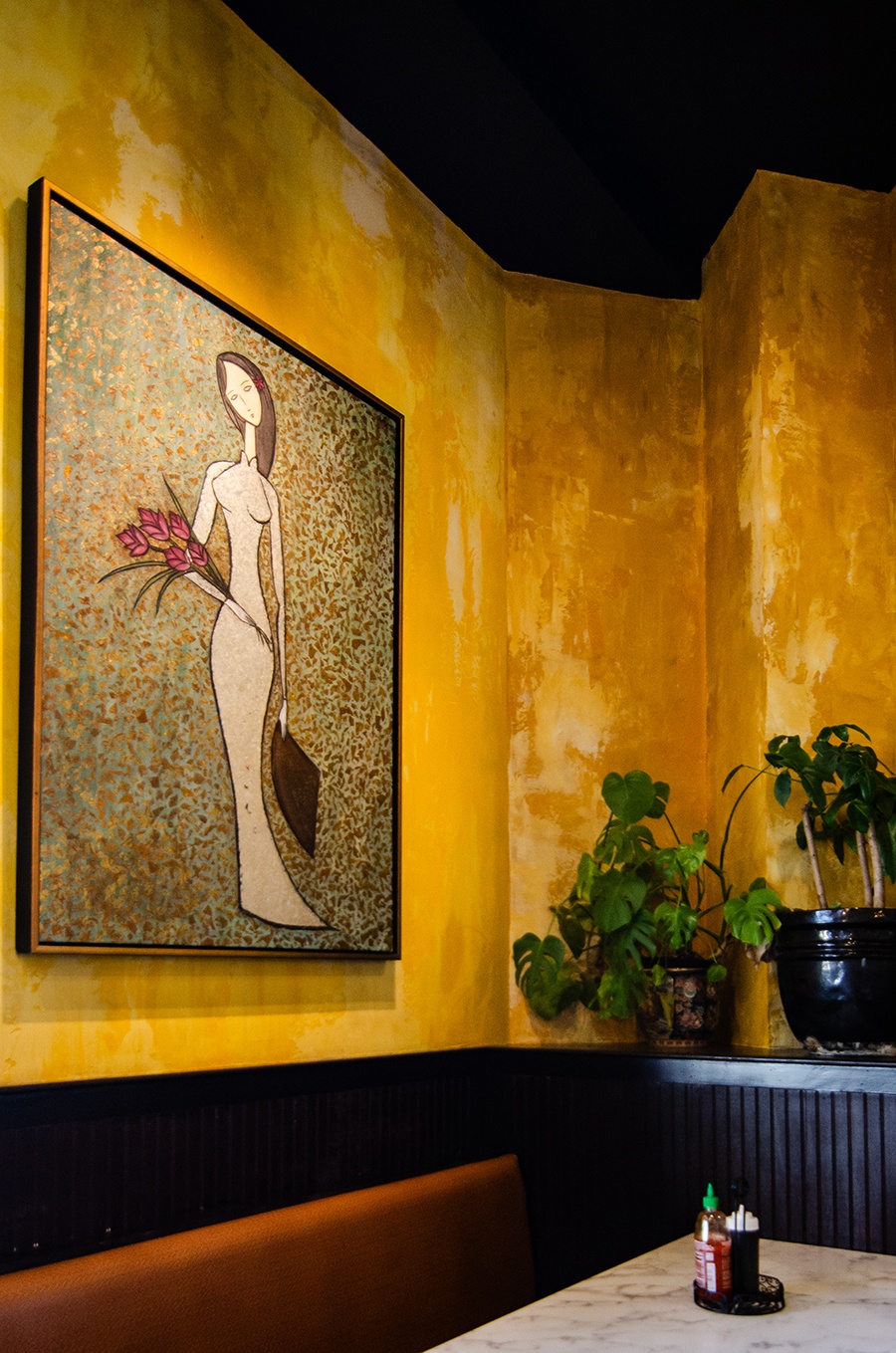
Lê Madeline. The painting is a commissioned work by Santa Fe-based artist Paul Zepeda. / Photo by Rachel Leah Blumenthal
But don’t take his word for it: The toughest critics are already charmed. “There’s no harder person to please food-wise than a Vietnamese grandmother,” says Yee, and so far, those who’ve come in have been happy, he reports back. “It’s better than receiving a James Beard award, a Michelin star. If you can pass a Vietnamese grandmother’s test, you’re golden,” says Yee. “Pete has done that with his food.”
Open for lunch and dinner six days a week (closed Tuesday). 409 Hancock St., Quincy, lemadeline.com.
